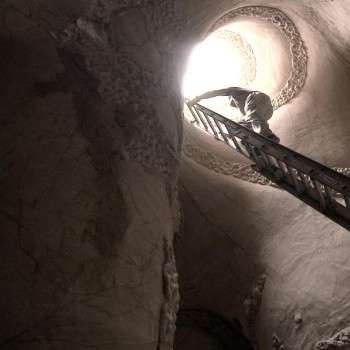“Cavedigger” is a documentary by producer/director Jeffrey Karoff about a quixotic sculptor in New Mexico who creates elaborate, beautiful caves carved into the natural landscape. Ra Paulette’s work may be beautiful, but nearly all of his private commissions have been dropped due to creative differences and his insistence on complete artistic control – leading him to give up on taking work for collectors at all in favor of focusing all his time on a massive, decade-long project all his own. The film has now been nominated for an Oscar for best short documentary of the year.

Jeffrey Karoff: I met Shell and Liz, who are two people that play prominently in the film, in the town where Ra does his work. And they had said that they were having a cave made on their property. My wife and I were intrigued and said, “Can we see it?” And they walked us towards the mountain where the cave was and it’s wild.
It’s nature, and then suddenly you’re walking up the set of stairs and there’s a door in the side of the mountain, which is already pretty odd. Then walking into their cave and coming around the corner and entering the space with the huge skylight and the sculpted walls was breathtaking.
I think it’s breathtaking for everybody that takes that journey. That’s a shot that I replicated in the film. That exact journey that I took.
Brendan Francis Newnam: How did Ra start digging caves?
Jeffrey Karoff: He doesn’t have any background as an artist at all. He was basically a laborer and he was a garbage man. He worked on farms. But he had some sense, I think, that he had something inside of him that he wants to express.
He said he saw a little cave that kids had dug, and from that recognized that the material was both malleable and firm. So it held up. And he started trying to do that himself. So it entirely came from something inside of him.
Brendan Francis Newnam: The opening portion of the doc is you marveling at this man, one individual against rock. But then that beautiful metaphor runs into other people. The patrons, his wife. Can you talk a little bit about some of the tensions around his project?
Jeffrey Karoff: Well, he is an artist, but what he makes is something that people who hire him to do these caves consider to be something more like architecture. So there is this conflict between is he an artist or is he a contractor?
If you commissioned a piece of art, you would never stand in somebody’s studio and say, “Add more of this color” or “Put a border on it.” But as these things unfold on the land that the patrons have commissioned the work, they’re there. And they’re coming in on a daily basis and they have ideas, which I found to be kind of humorous because, here’s a guy who’s doing something that has never been done before. Creating caves that are works of art. And yet his patrons all have opinions about what they should be. And I was always curious about where did those opinions come from? What are you comparing this to?
Brendan Francis Newnam: Another tension you explore in this movie is between Ra and his wife. She basically supports him. When he is doing commission work he’s not earning very much money. And he often isn’t doing commissioned work and he’s building his own caves, and she seems frustrated by that a little bit, and he talks about the tension in their marriage around that. And at one point she says that he has kind of a Peter Pan complex.
Jeffrey Karoff: Well I think what she means by that is that his obsession has made it so that he doesn’t pursue things that the rest of us pursue, like recognition, remuneration, advancement. All of those things that we all hold dear, we mere mortals hold dear, and we compromise many things in order to get those things. He’s not willing to compromise to get those things.
Brendan Francis Newnam: Do you feel like he’s found what he’s seeking? Has his path lead him to where he wants to be?
Jeffrey Karoff: That’s an interesting question. He talks about the value of process all the time.
So you know from watching the film, there was an accident in one of his caves and that the project came to an end, and one of the things that launched me on making the documentary was that I spoke to him probably seven days after that project shut down and he had been working on that for almost two years.
I was shocked and I was saddened by the whole thing, and I expressed all of that to him on the phone. And he said, “Yeah well it was pretty shocking but on the other hand I’m really excited about this project that I’ve got going now.” And this was really seven days afterwards.
Who does that, except somebody for whom the process is even more important than the product.
Brendan Francis Newnam: And the movie ends with him starting that project. He calls it Magnum-Opus 2, because Magnum-Opus 1 is the thing that fell apart. And he predicts that it’s going to take him a decade to complete. He’s in his 60s. He thinks that this will take him to the end of his cave-digging years.
It’s a magnificent shot. You see Ra attacking the mountain with his little pickaxe. He’s just beginning to dig this immense cave. And then the camera pans back and he becomes just a little speck and the sound of his tools smashing against the mountain turns into a little plink. And the viewers are left wondering if they’re staring at Sisyphus or Michelangelo.
Jeffrey Karoff: That’s a nice way to think about it.
Brendan Francis Newnam: Jeffrey thanks so much for coming by and chatting with us about this.
Jeffrey Karoff: Thank you very much.


